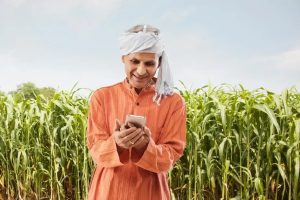The curious case of the farmer with the smartphone

Photo by India Picture on Shutterstock.
In our previous blog post, we summarized preliminary findings from our ongoing work on the various factors influencing user learning and experience in the context of smartphone based digital agri-service/financial apps for the farmer segment. Here, we highlight and discuss an interesting anomaly when it comes to the usage of mobile phone applications in our study areas.
Of the smartphone users we surveyed, we find that a majority (~60% in Karnataka, for example) use their smartphones to access online entertainment and social media (Youtube, WhatsApp, Facebook etc.). At the same time, we see that a lack of digital literacy, and a lack of familiarity with technology are commonly cited challenges when it comes to the adoption and usage of agri-service/ financial applications. This poses an interesting question — how do users overcome challenges of literacy or skill for instance, when it comes to using social media and other applications on their phone? Is there anything specific about these applications that make them easier to use, or more intuitive perhaps?
While there is a lack of literature and theory specific to mobile application adoption and usage, there are several existing models of technology adoption and usage, which offer some insights in this regard. The Technology Adoption Model (TAM), for example, suggests that perceived usefulness, as well as the perceived ease of usage play a vital role in influencing technology adoption and usage. The Unified Theory of Acceptance and Use of Technology (UTAUT), at the same time, identifies factors such as performance expectancy (perceived usefulness, extrinsic motivation etc.) and effort expectancy as key drivers of technology adoption. Extensions to these models also highlight a number of determining factors influencing mobile phone adoption and use. These include social influence — the pressure exerted on the individual by the opinions of others, and facilitating conditions- like the necessary infrastructure for example, among other things (Van Biljon and Kotzé).
These models are particularly useful in the context of our objectives — i.e.- understanding the role of product/interface design and related factors that influence and enhance the usability of smartphone based agri/financial services. As we have highlighted in earlier posts, interface design appears to play a major role in influencing usability. Given the anomaly we mention above, it is important to consider whether there are any specific design elements of various social media and other popular applications that influence user perceptions; and in turn investigate how such elements may be incorporated into other applications offering critical services. This question will form the crux of the last part of our fieldwork. Additionally, we will also seek to explore the role of social influence in determining adoption and usage of smartphone based agri/financial services in our study areas.
The second aspect of these issues that our study focuses on pertains to the question of imparting digital literacy skills, in a sustainable way, to ensure that users are able to navigate the landscape of available solutions in an informed and competent manner. The various models we discuss earlier offer some useful frameworks to think about these points as well. For example, existing training programs appear to focus purely on information dissemination, and seem to have less of a focus on aspects such as building motivation, or on demonstrating the usability and usefulness of available app-based solutions. Thus, the last leg of our study will also attempt to address this aspect. Our aim in this regard will be to provide a roadmap/ guide of sorts to various stakeholders, shedding light on how digital literacy and skill-building programs could be aligned better to effectively influence the adoption and usage of digital financial technologies.
References
[1] Biljon, Judy V, and Kotzé, P. “Cultural Factors in a Mobile Phone Adoption and Usage Model” Journal of Universal Computer Science. 2008.
This research was developed as part of the Bharat Inclusion Research Fellowship.
